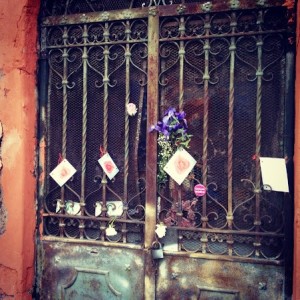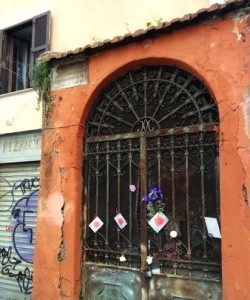The Shrine of Papessa Giovanna

Complete with an “ORDAIN WOMEN” button
In the Celio neighborhood of Rome, on a quiet street behind the Colosseum, there is a small shrine dedicated to the legend of Pope Joan, Papessa Giovanna. Fact or fiction, legend or parody, the flowers are fresh on this small shrine.
Perhaps appropriately there is a triangular construction site, sectioning off a hole in the road immediately in front of the portico. It is said that following mass at St. Peter’s, en route to the 9th century papal residence, St. John in Lateran, the papal procession was surrounded by crowds causing the Pope’s horse to rear, and sending the pregnant Papessa into labor.
When her secret was discovered, some say she was flogged and tied by her feet to her horse and dragged through the streets of Rome. Later that day she is said to have been killed (the dragging didn’t do it?) on the banks of the Tiber and her body was buried at this shrine. Although throughout the later Middle Ages there are many mentions of a woman pope, legend varies as to when, how, and the possibility of Protestant and anti-Catholic writing helping the cause. Interestingly, according to Martin of Opava, medieval popes, from the 13th century onward, did avoid the direct route between the Lateran and St Peter’s, and there is no evidence that this practice dated back any earlier. The origin of the practice is uncertain, but it is quite likely that it was maintained because of widespread belief in the Joan legend.
It is fun to read about the widespread fascination with the possibility of a woman pope, and as feminist hermeneutics would require, I must imagine where women have been made invisible, especially in the Church. But for me, it is the devotion and fascination — the living legend that brings pilgrims to this site that is most interesting. I left an “ORDAIN WOMEN” button and several bills of “Funny Money” at the spot, at the request of a WOC board member.
 On my wandering walk home, an Italian man joined my stride and attempted the line: Ti piace questa musica? We were in the midst of a street fair, complete with indigenous American music and traditional dancing. I said no, which is generally the single response I give when approached on the street like this, but he switched to English and asked if I spoke English, if I was Irish, commented that my eyes matched my shirt…. He asked, “do you want to go for a walk with me?” and then, “why are you rushing?” I said I had to get home to work, and just like that, like any happy hour in D.C., we started talking about women’s ordination and the Catholic Church.
On my wandering walk home, an Italian man joined my stride and attempted the line: Ti piace questa musica? We were in the midst of a street fair, complete with indigenous American music and traditional dancing. I said no, which is generally the single response I give when approached on the street like this, but he switched to English and asked if I spoke English, if I was Irish, commented that my eyes matched my shirt…. He asked, “do you want to go for a walk with me?” and then, “why are you rushing?” I said I had to get home to work, and just like that, like any happy hour in D.C., we started talking about women’s ordination and the Catholic Church.
At first I said I work for women in the church, my classic line. Then I mentioned working with le sorelle, hoping to leave it at that: what I thought was a fairly universally benign and beloved topic. The man said something that I’ve never heard before, to the effect of: “Sisters, they are so lazy. All they do is pray, what else?” At this point we had covered some ground, and standing between Il Colosseo and il Foro Romano, we both stopped walking. In a mix of Italian and English nouns I tried to explain what sisters do in the U.S., to which he asked if I worked at a hospital. Okay, I’ll bite: cue women’s ordination street ministry 101.
The man explained that he stopped going to church when he was 21, even though he used to go every two weeks. He had a priest that he really liked, but then… he trailed off. He thought about women priests and said yes, that could be okay (“Va be, Va be”), but is it possible? Some jobs are better for men than women: “Like I could never work in a shop or be a secretary.”
I said it is possible (for you to work in a shop) and for women to be priests, but there are many, many cultural barriers. I said, even though most people think it would be okay for women to be priests, the Church is very patriarchal. “Like the man is the boss?” he said.
Si, esatto.
I mentioned that yesterday Papa Francesco named 19 new cardinals (to which he said, “I think I heard something about that…” — blessed perspective!), all men. But there is no rule against a woman being a cardinal. It is possible, I said. At this point, the man again asked if I wanted to go for a walk with him (women cardinals on a sunny afternoon — tempting!). “No, no… mio fidanzato is waiting for me…” He understood and said, “Oh you will be in trouble if you don’t get home. Allora, I will think of you a lot when there is the first woman pope.”


5 Responses
Loved reading this, Kate. I felt like I was in Rome with you visiting this shrine. Fascinating legend. Love that you left the ordain women button and the man’s last statement to you….WHEN there is a woman priest. Peace to you and God bless.
Thanks Marilu! It is really fascinating!
Ordain Kate! The church is dying in its denial of women in their rightful place.
I’ve been to San Clemente many times, and never realized this shrine was so close. I will be visiting Rome again in February for the Ireland/Italy rugby match (coming from the USA), and will be sure to visit.
Thanks for the info.
Brian.
I visited Pope Joan’s shrine last year. It is a fascinating tale. I prefer that she did penance then joined her son who was by then a bishop. I think in Germany.
The other ending is more likely but I don t like it Jo